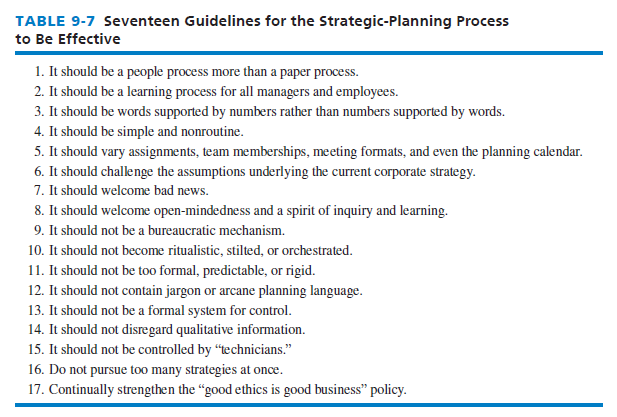Failing to follow certain guidelines in conducting strategic management can foster criticisms of the process and create problems for the organization. Issues such as “Is strategic management in our firm a people process or a paper process?” should be addressed. Some organizations spend an inordinate amount of time developing a strategic plan, but then fail to follow through with effective implementation. Change and results in a firm come through implementation, not through formulation, although effective formulation is critically important for successful implementation. Continual evaluation of strategies is also essential because the world changes so rapidly that existing strategies can need modifying often.
Strategic management must not become a self-perpetuating bureaucratic mechanism. Rather, it must be a self-reflective learning process that familiarizes managers and employees in the organization with key strategic issues and feasible alternatives for resolving those issues. Strategic management must not become ritualistic, stilted, orchestrated, or too formal, predictable, and rigid. Words supported by numbers, rather than numbers supported by words, should represent the medium for explaining strategic issues and organizational responses. A key role of strategists is to facilitate continuous organizational learning and change.
- T. Lenz offers six guidelines for effective strategic management:
- Keep the process simple and easily understandable.
- Eliminate vague planning jargon.
- Keep the process nonroutine; vary assignments, team membership, meeting formats, settings, and even the planning calendar.
- Welcome bad news and encourage devil’s advocate thinking.
- Do not allow technicians to monopolize the planning process.
- To the extent possible, involve managers from all areas of the firm.20
An important guideline for effective strategic management is open-mindedness. A willingness and eagerness to consider new information, new viewpoints, new ideas, and new possibilities is essential; all organizational members must share a spirit of inquiry and learning. Strategists such as chief executive officers, presidents, owners of small businesses, and heads of government agencies must commit themselves to listen to and understand managers’ positions well enough to be able to restate those positions to the managers’ satisfaction. In addition, managers and employees throughout the firm should be able to describe the strategists’ positions to the satisfaction of the strategists. This degree of discipline will promote understanding and learning.
No organization has unlimited resources. No firm can take on an unlimited amount of debt or issue an unlimited amount of stock to raise capital. Therefore, no organization can pursue all the strategies that potentially could benefit the firm. Strategic decisions, then, always have to be made to eliminate some courses of action and to allocate organizational resources among others. Most organizations can afford to pursue only a few corporate-level strategies at any given time. It is a critical mistake for managers to pursue too many strategies at the same time, thereby spreading the firm’s resources so thin that all strategies are jeopardized.
Strategic decisions require trade-offs such as long-range versus short-range considerations or maximizing profits versus increasing shareholders’ wealth. There are ethics issues, too. Strategy trade-offs require subjective judgments and preferences. In many cases, a lack of objectivity in formulating strategy results in a loss of competitive posture and profitability. Most organizations today recognize that strategic-management concepts and techniques can enhance the effectiveness of decisions. Subjective factors such as attitudes toward risk, concern for social responsibility, and organizational culture will always affect strategy-formulation decisions, but organizations need to be as objective as possible in considering qualitative factors. Table 9-7 summarizes important guidelines for the strategic-planning process to be effective.

Source: David Fred, David Forest (2016), Strategic Management: A Competitive Advantage Approach, Concepts and Cases, Pearson (16th Edition).

17 May 2021
18 May 2021
17 May 2021
17 May 2021
18 May 2021
17 May 2021